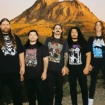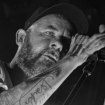The low-key members of veteran Swedish metal band In Flames like to laugh. They laugh when they drink too much, when they're playing poker, when someone belches, farts, or makes a stupid joke—and when they're called the "forefathers of the Gothenburg melodic death-metal movement." But most of all they laugh when they think about all the modern bands they've inspired over the years, including Shadows Fall, the Black Dahlia Murder, and As I Lay Dying.
"It's so strange to hear bands today say In Flames are the reason they picked up a guitar, because when I started In Flames, it was just a hobby with some friends," says guitarist Jesper Strömblad, the only remaining original member. "And it's just really funny to wake up 15 years later and think, OK, we helped start something here."
The success didn't come without plenty of touring, some personnel shifts (though the lineup has been stable since 1999), and a fair amount of criticism from fans irked by the band's need to evolve. In the beginning, In Flames were, indeed, pioneers of Gothenburg's melodic death-metal movement, alongside At the Gates and Dark Tranquillity. Their music combined the twin-guitar harmonies and sharp-toothed melodies of New Wave of British Heavy Metal bands like Iron Maiden and Judas Priest with the speed and aggression of death-metal legends such as Morbid Angel and Cannibal Corpse.
But as In Flames developed, their music changed. Death-metal beats became scarce, replaced by slower, more syncopated drumming, and some of the guitar bite yielded to textural keyboard washes. At the same time, the vocals incorporated less growling and more gravelly singing. Even today, the band continues to take heat from old-school fans who accuse them of trying to latch on to the nu-metal and metalcore movements.
"That's the last thing we ever had on our mind," singer Anders Fridén says. "We never aim to do something in any way. Whatever comes out is what we do, and that's always been the philosophy of In Flames."
Shortly after In Flames finished their new studio album, A Sense of Purpose (Koch), Revolver talked at length with Fridén (and briefly with Strömblad) about the changes they have experienced, the obstacles they have overcome, and the growth they have undergone over their 10 albums together. And that's nothing to laugh at.
LUNAR STRAIN
(Wrong Again, 1994)
When Strömblad was a member of Ceremonial Oath, he decided to write some songs on the side with guitarist Glenn Ljungström and various friends. After penning three tunes, he roped in Dark Tranquillity rhythm guitarist Mikael Stanne to sing. The chemistry was explosive, and when the metal world heard the band's combustive songs, Ceremonial Oath was put on the backburner.
"We had no intention of getting a record deal or anything when we did the demo," Jesper Strömblad says. "But then the guys in Dark Tranquillity told us they had been contacted by a Swedish label, Wrong Again Records, but that they had just signed to Spinefarm. So we got drunk and called the Wrong Again guy up from my parents' kitchen. He asked us if we had songs for an entire album, and even though we only had those three songs, we lied and said, 'Yeah, no problem. We can enter the studio any day.' So he signed us.
THE JESTER RACE
(Nuclear Blast, 1996)
In response to the success of Lunar Strain, metal powerhouse Nuclear Blast Records signed In Flames to a multi-album contract. Since Stanne was committed to Dark Tranquillity, Strömblad invited Fridén to join, and current In Flames guitarist Björn Gelotte was brought in on drums. Caught up in the tide of musical energy sweeping Gothenburg, the band wrote some of the fastest, darkest, and most powerful songs of its career.
"We weren't thinking about trying to fit into a scene; we were just writing music we loved," Fridén says. "It was funny because [bassist] Johan Larsson was doing the military, so he only came home on weekends and did his stuff. For the lyrics, I had some ideas about how man was lending too much of our brains to machines and the machines took over. The story continued on the next album, Whoracle, which was about how to rebuild after the machines had left. Those were the only concept records I will ever do."
WHORACLE
(Nuclear Blast, 1997)
While Fridén and Strömblad were ready to circle the globe with In Flames, Ljungström and Larsson didn't like to travel and were losing interest in the band. Even so, they kept it together in the studio for Whoracle, which features an impressive array of acoustic instrumentation ("Whoracle"), thrash-metal punch ("Jester Script Transfigured"), and melodic death-metal savagery ("Jotun").
"Glenn was the only one of us who had a real job, and he saw that there was no money in what we were doing and I think he wanted security," Fridén recalls. "And Johan met a girl on the Internet and they fell in love, so he put the bass on the shelf."
COLONY
(Nuclear Blast, 1999)
The departures of Ljungström and Larsson injected fresh life into In Flames. The band hired bassist Peter Iwers, who was the brother of one of their first guitarists, Anders, and moved Gelotte to the second guitar slot. Then they recruited drummer Daniel Svensson from Sacrilege GBG and entered the studio to record Colony, a more accessible release that features semi-melodic vocals alongside death growls. Along with Whoracle, Colony is the In Flames album most representative of the "Gothenburg sound" and the one that had the greatest impact on the future of metalcore.
"Finding Daniel was very important, because now we had a real drummer that could play his ass off," Fridén says. "Björn could keep a beat, but he could only play, like, one fill. He's much better on guitar. Also, I decided to leave behind all the made-up stories in my lyrics and write about my own mishaps and relationship problems. Everything was clicking and it really felt like we had found the team that we needed to be In Flames."
CLAYMAN
(Nuclear Blast, 2000)
For more than five years, In Flames seemed content to write songs that fit in with the thriving Gothenburg scene, but with their fifth album, the band took its first concrete steps away from the sound it had helped pioneer. The songs were still heavy and filled with intricate, intertwining guitars, but they were also experimental, including sampled beats, textural synths, and cleaner vocals. Clayman bridged the gap between classic In Flames and the more commercial approach the band would take with releases to follow. It was also the last of four discs produced by definitive Swedish metal producer Fredrik Nordström (At the Gates, Arch Enemy, the Crown, Dark Tranquillity).
"The whole recording process with Fredrik wasn't the greatest, because he was tired of producing bands and we didn't feel like he was really into it," Fridén says. "It's funny, because the studio where we recorded Clayman is the same one where we recorded the new record, but now we own the place. The lyrics on Clayman were very personal to me. I had just been through a bad breakup and I felt unsure of who I was, so the title was me saying, 'I'm clay, and you can use me, form me into whatever. I'll try to adapt.'"
THE TOKYO SHOWDOWN
(Nuclear Blast, 2001)
With five studio discs behind them, In Flames were encouraged by their label to release a live album. At first, the band liked the idea, so they hired a Japanese company to record one of the shows on their Asian tour.
"It was recorded on ADAT, and when we listened back to the tapes they sounded like crap," Fridén says. "We mixed it and did the best we could with it, but the label was already planning the release, so we couldn't stop it. That's the only record I regret putting out."
REROUTE TO REMAIN
(Nuclear Blast, 2002)
It may be no coincidence that Reroute to Remain was the first In Flames album to be criticized by old-school fans and the first that the group's current producer, Daniel Bergstrand, worked on. However, for followers of mainstream metal, the disc was crafty, multifaceted, and heavy as iron ore but never lacking in strong choruses. Clearly, the band was reaching for a new audience, but they refused to dumb down their music or compromise creatively to sell records.
"Daniel had a whole different approach and vision," explains Fridén. "That changed the sound for sure, but I don't think the music changed that much. It was just a weird time. We toured with Slipknot for Clayman, and then when we were about to put out Reroute to Remain, people were saying we sounded like Slipknot. There was a sort of mass hysteria, which was very strange. It was also a very hard record for me because Fredrik had always let me sing however I wanted, and Daniel really pushed me and made me do parts over and over. I wasn't used to that."
SOUNDTRACK TO YOUR ESCAPE
(Nuclear Blast, 2004)
In search of a new creative environment, In Flames traveled to Denmark to record Soundtrack to Your Escape. They rented a house and built two different studios there, one for vocals and bass and the other for guitars and keyboard. The separation was representative of the division the musicians were feeling with each other. Still, for fans of their previous album, Soundtrack to Your Escape was hardly disappointing—a nu-metal-flavored onslaught flush with overt hooks, angst-laden vocals, and a surprising emphasis on keyboards.
"When we were doing it we weren't exactly sure what kind of sounds we were getting because we were in a new studio," Fridén says. "When we went to Belgium to mix it, we were a little surprised by what we had. There was a little bit too much keyboard and I think there should have been more solos and guitar melodies. But I still think Soundtrack sounds good, especially considering how much arguing there was. We just needed a break from each other."
COME CLARITY
(Ferret, 2006)
Following an unpleasant run on Ozzfest, during which In Flames fought regularly, the members decided to work on their next album from three different cities. Svensson recorded drums at Dug-Out Studios in Uppsala, Sweden, while Gelotte, Strömblad, and Iwers worked at their space in Gothenburg, and Fridén tracked in a studio in Umeå. However, this time, the division seemed to benefit the band. While Come Clarity hardly marked a return to the group's melodic death-metal roots, it was tougher and featured more thrash elements and guitar solos than anything since Clayman.
"Some people call it a comeback album, but we never went away," Fridén says. "I think it was good that we had more guitar than keyboards, but I also think we lost a little bit of the band feeling we used to have, and there wasn't much communication. When I was mixing the album, I did it without the other guys hearing a note of my vocals. And I just sent them down, hoping they would like them."
A SENSE OF PURPOSE
(Koch, 2008)
After taking almost a year off, In Flames regrouped with renewed vigor and determination. There was also a sense of camaraderie the band hadn't experienced in a very long time. Instead of remaining divided physically and philosophically, the musicians gathered at their studio, IF, in Gothenburg, shared a few dozen beers, and worked together in a spontaneous and democratic fashion, with everyone having creative input in what the others were doing. As a result, A Sense of Purpose sounds immediate and eclectic, contrasting tight-fisted rage with catchy songwriting, intermingling a wide range of gruff and raspy vocals with rhythms that combine elements of nu-metal, thrash, NWOBHM, and even alternative rock.
"I think we got a new feeling within the band," Fridén says. "It reminded me of how I felt when I first joined and everything was fresh and exciting and we felt like we were there for each other no matter what. Everyone was really pitching in to do our own thing. Our attitude was, 'We know people try to put us in different genres, so let's just ignore all that and make a fucking awesome metal album that we want to listen to today.' We worked really hard on each and every sound from day one to make this thing awesome, and I think we succeeded."












